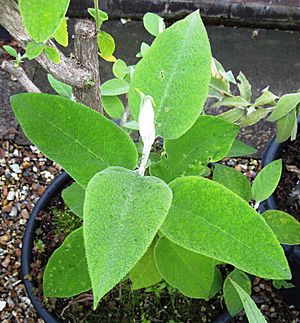Buddleja crotonoides facts for kids
Quick facts for kids Buddleja crotonoides |
|
|---|---|
 |
|
| Buddleja crotonoides foliage, Longstock Park Nursery | |
| Scientific classification | |
| Genus: |
Buddleja
|
| Species: |
crotonoides
|
| Synonyms | |
|
|
Buddleja crotonoides is a type of shrub that grows naturally in many places. You can find it from California in the north, all the way south to Nicaragua. This plant often grows in oak forests and on rocky slopes. It usually lives high up in the mountains, between 2,000 and 2,500 meters (about 6,500 to 8,200 feet) above sea level. It often grows near other plants like the Arbutus xalapiensis tree, different kinds of Pine trees, and the Crataegus mexicana shrub. A scientist named Asa Gray first officially named and described this plant in 1847.
Description
Buddleja crotonoides can grow into a large shrub or even a small tree. It can reach a height of up to 5 meters (about 16 feet). One special thing about this plant is its large leaves. They can be up to 20 centimeters (about 8 inches) long. Both the top and bottom sides of the leaves are covered with thick, soft hairs.
The flowers of Buddleja crotonoides grow in clusters called inflorescences. These flower clusters can be up to 20 centimeters long. The flowers themselves are usually a greenish-white or greenish-yellow color.
Growing Buddleja crotonoides
Buddleja crotonoides is not very common in the UK. Some special plants are kept at the Longstock Park Nursery, near Stockbridge. This nursery has a national collection of plants from the NCCPG.
This shrub is not very strong against cold weather in the UK. It can sometimes survive if it is protected from frost. It's best to keep it in a pot so it can be moved indoors when winter comes. This plant grows best in areas with a mild climate, like USDA hardiness zone 9. This means it prefers places where the lowest winter temperatures usually don't drop below about -6.7 degrees Celsius (20 degrees Fahrenheit).

